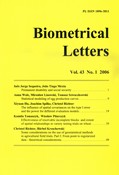
Biometrical Letters vol. 43(1), 2006, pp. 49-66


Over the last years, agricultural experimenters have shown increased interest in geostatistical methods. Geostatistical methods provide the opportunity to take into account spatial dependencies between plots in experiments. The spherical or the exponential model is often used to describe the dependence. Originally, however, these models were developed however, for point data. In agricultural field experiments, the data mostly result from transects or plots which are laid out on grids in the x-y plane. Transect or plot data arise by regularization of point data. Assuming the spherical and the exponential model (with isotropy and anisotropy, with and without nugget) as the initial models, we investigate the covariogram functions and their characteristic parameters for different regularizations in part I of this paper. Because explicit expressions for the resulting covariance functions can be specified only as an exception, we made use of simulations. The calculations were performed in both the x- and y-directions as well as omnidirectionally. Except for isotropic initial covariograms and quadratic plots, the regularized covariograms show anisotropy in all cases and are generally characterized by a sigmoid shape. In the second part of this paper which will appear in the next issue of the Biometrical Letters, the theoretical results will be confronted with those from uniformity trials.

geostatistical methods, point data, regularized data, agricultural field trials

